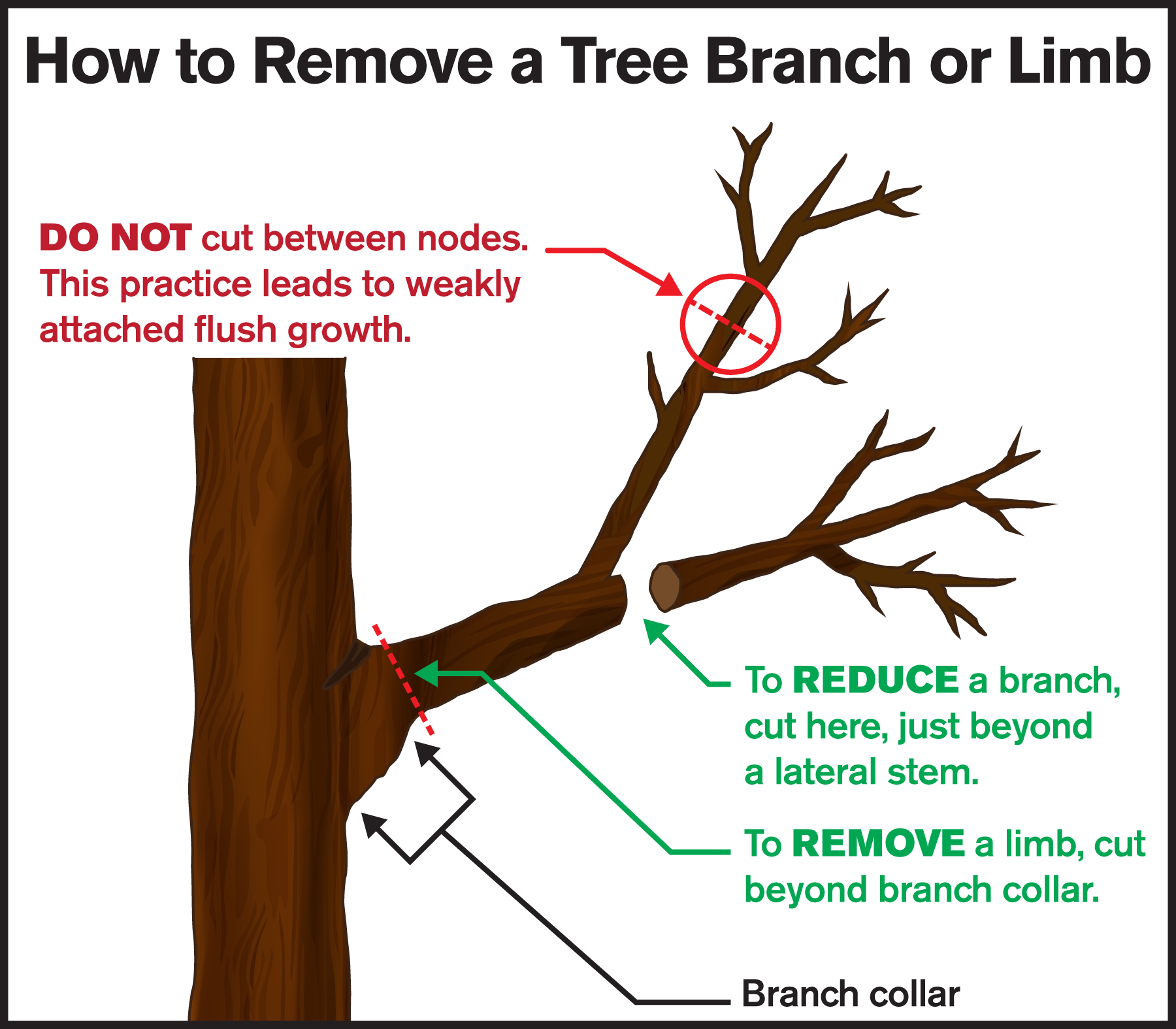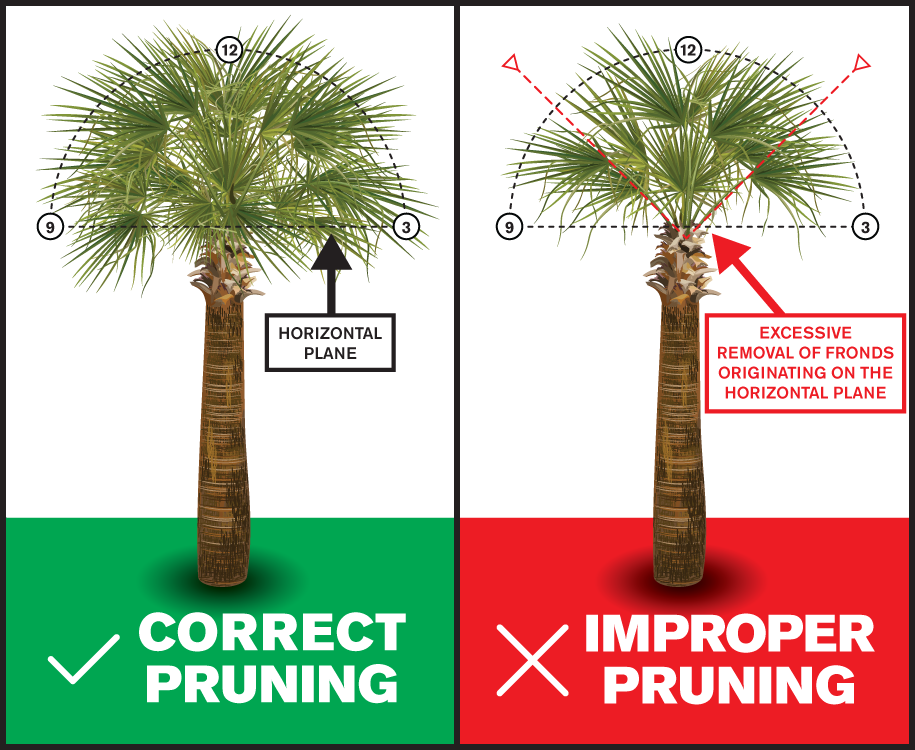Tree and Palm Pruning

Proper pruning is essential to maintaining the health, structure, and safety of your trees. Every cut has a lasting effect on how a tree grows, making it important to prune correctly so the tree can protect itself from pests, disease, and decay.
Pruning encourages a strong central trunk with well-spaced branching and provides clearance for pedestrians, vehicles, and nearby structures. It also reduces the weight of weakly attached limbs and improves air flow and light penetration by thinning the canopy.
When done properly, pruning strengthens young trees, reducing the need for corrective work as they mature. Well-pruned trees are more resilient to windstorms and other severe weather, while improperly pruned trees are more likely to fail.
Proper Pruning Guidelines
- Pruning should be throughout the entirety of the crown of the tree, not just the bottom branches.
- Remove dead, damaged, or diseased branches.
- Eliminate limbs that cross or rub against each other.
- Maintain the interior limbs of a shade tree; they increase the stability of a tree.
- Cuts should be made on a slight angle just beyond the branch bark ridge and outside of the branch collar.
Branch Bark Ridge - the raised area located at the connection where two branches meet
Branch Collar - the swollen area just below the attachment where two branches meet
Improper Pruning Cuts
Care should be made at all times to minimize hazards and devise a pruning plan that will encourage a strong structure throughout the tree’s canopy. Improper pruning cuts can weaken your tree and may result in a code violation. Below are some examples of improper pruning practices.
- Flush Cut – cutting into the branch bark ridge and inside the branch collar
- Stub Cut – a cut made between two nodes where branches do not meet
- Lions-tailing – the removal of an excessive amount of branches in the interior portion of the canopy, leaving the majority of leaves out toward the ends of the branches, resulting in an uneven distribution of foliage
- Topping or Hat-racking – heading cuts that shorten limbs or branches back to a predetermined point in the canopy
- Over-lifting – the removal of an excessive number of branches in the lower portion
- Over-thinning – the removal of an excessive number of inner, lateral branches from parent branches
Over Lifting/Thinning
Lifting trees is a common pruning practice where the lower branches of the tree are removed to provide clearance for cars, structures, etc. Over lifting, or excessive thinning of trees, is a poor pruning practice. This type of pruning causes trees to be top heavy, reduces trunk taper and increases the chances of branch breakage. It also disfigures the natural form of the tree.
Why is it bad for trees?
The center of gravity is pushed higher up into the canopy, leaving the tree vulnerable to higher wind speeds. The foliage is concentrated at the ends of branches which reduces branch taper, destroys the natural form of the tree, and it increases the likelihood of limbs breaking.
Pruning should result in the even distribution of branches throughout the entire crown, not just the top. Trees should be inspected every year. Remove dead and crossing/rubbing branches and prune to encourage good structure. Older trees that have been maintained properly do not need pruning every year.
Topping or "Hat-racking"
Topping a large tree, also known as “hat-racking”, causes excessive sprouting of weakly-attached new branches and also increases wind resistance by creating a denser branch pattern. Topping is a type of pruning where most of the canopy is removed from the tree, leaving mostly branch stubs. Topping initiates decay in the trunk and main branches and attracts wood boring insects. Topping is equivalent to butchering a tree.
Why is it bad for trees?
It causes decay in the trunk as well as excessive sprouting below the topping cut. The sprouts may be weakly-attached to a decaying column of wood. As the sprouts gain in size, in length, and weight, the likelihood of failure increases.
How does it affect you?
Trees become potentially hazardous and will increase maintenance costs. They can also create liability and potentially subjects the property owner to incur fines.
Palm Pruning
Palms do not require much pruning. Palms produce their own food so, when possible, the green fronds should remain on the palm. It also enables the production of food for future storage during times of stress, such as cold and drought. Over pruning leads to weakened palms and, in some instances, may even result in the tree dying. Whenever possible, only remove dead fronds, flower stalks and seedpods.
Do not use nails or screws to attach lights or signs to the trunk. Puncture Wounds Never Heal.
Do not use climbing spikes to climb any tree.
Do not use a machete to remove fronds as an overstrike will wound the trunk of the tree.
Do not use string trimmers to trim away grass from the trunk. string trimmers can slowly remove the bark from the base of the tree. Do use mulch to keep grass away from the trunk.


